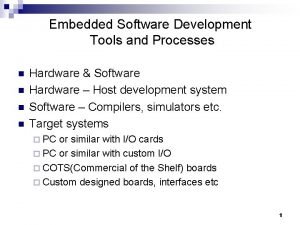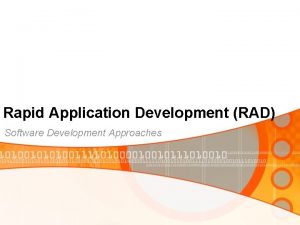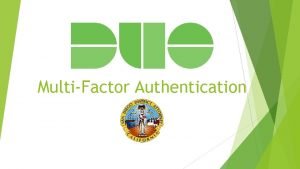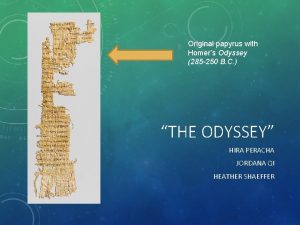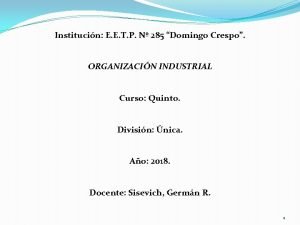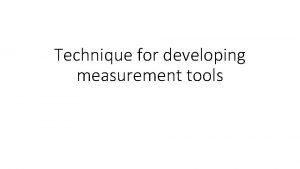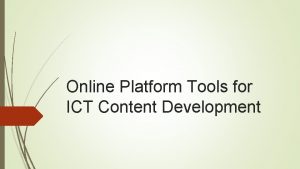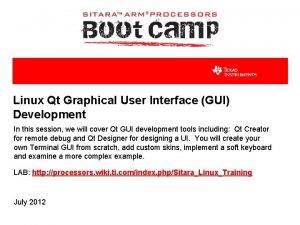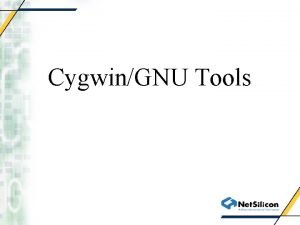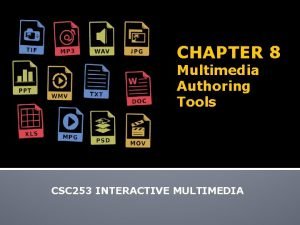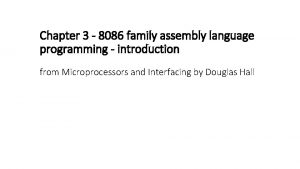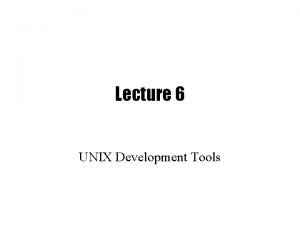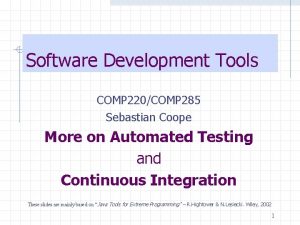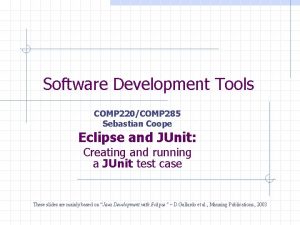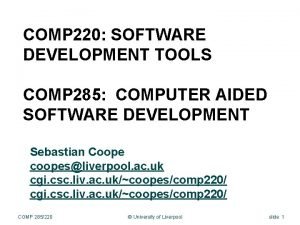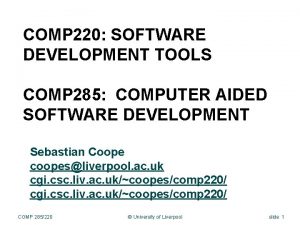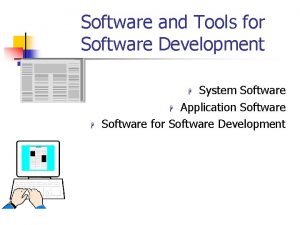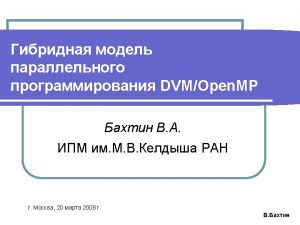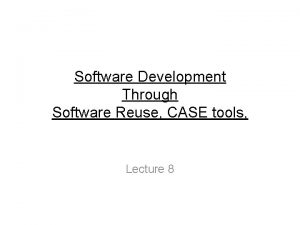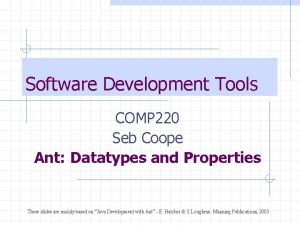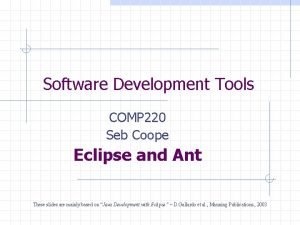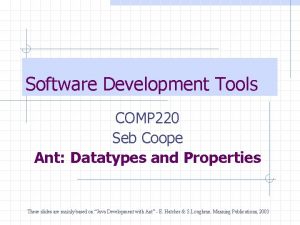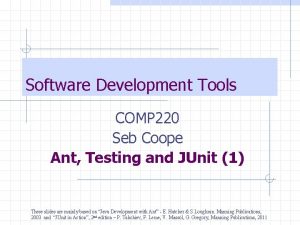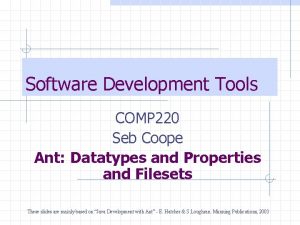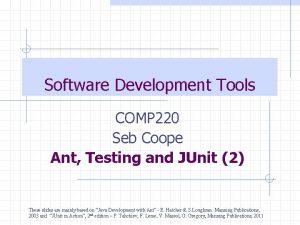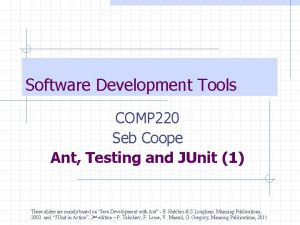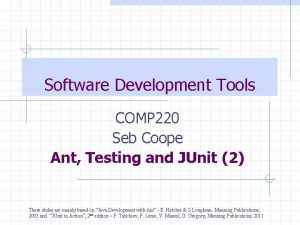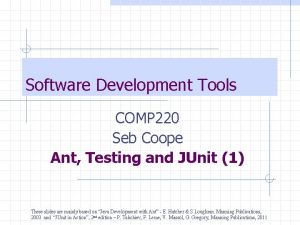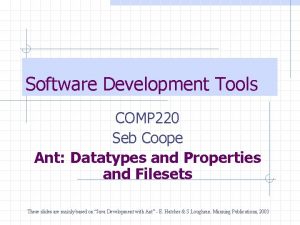Software Development Tools Lecture 2 COMP 220COMP 285






























- Slides: 30

Software Development Tools Lecture 2 COMP 220/COMP 285 Sebastian Coope Programming Methodologies These slides are mainly based on “ Java Tools for Extreme Programming” – R. Hightower & N. Lesiecki. Wiley, 2002 1

Topics Two kinds of programming methodologies • traditional • agile We will concentrate on e. Xtreme Programming (XP) methodology • example of an agile methodology of most interest to us 2

Software Development Methodologies Software Development Methodology is a collection of procedures, techniques, principles and tools that help developers to build computer system 3

Software development methodologies There are two main approaches to development methodologies: • Traditional monumental or waterfall methodologies • Agile or lightweight methodologies 4

Traditional methodologies • Rigid: § first a complete functional specification, § then software development process with several distinct waterfall-like phases • Problems: § difficult to adapt to changing customer requirements § design errors are - hard to detect and - expensive to correct 5

Waterfall issues What is customer doesn’t like the end product What if requirements start to change? What if project runs out of time/money? How is risk managed? How is QA managed (at the end !!) 6

Agile methodologies Agility in a software development means • adaptability • ability to respond quickly to change in environment • eliminate surprises from changed requirements • Risk reduction • Less chance of validation errors 7

Agile methodologies • emphasizes an iterative process: - build some well-defined set of features - repeat with another set of features, etc. • value customer involvement (quick feedback) • code-centric, i. e. - recognize the value in documentation and modelling - but realize that it is not as important as the software itself 8

Self documenting code Using long meaningful names n n account. Balance. In. Pence Comments n What to change code behaviour w static final int RETRY_LIMIT=3; // Change this value if you want to change the maximum number of times an incorrect PIN can be entered n TODO w Any areas that can be improved or require completion w TODO … check for stolen cards and credit risk 9

Testing in agile methodologies • Software development is - a mix of art and engineering. • The only way to validate software is through testing • All agile methodologies emphasize testing • Testing can be • Functional (specific yes or no tests based on functional specification) • Non-functional (stress testing, usability, security testing etc. ) 10

SCRUM Agile approach Each iteration of software development called a sprint Each sprint delivers working code or partial product Each phase requires a set of tests Testing is integrated 11

SCRUM ITERATION 1 ITERATION 2 ITERATION 3 Plan 1 Develop 1 Test 1 Plan 2 Develop 2 Test 1&2 Plan 3 Develop 3 Test 1&2&3

SCRUM phases Specification at start Then each development phase can be n Specification , Design, Coding Each iteration tests n n New functions All old functions (regressive) Testing is extensive, must not be burdensome 13

Testing-driven development • Put testing first in the development process • Before implementing a piece of code such as a Java method, start writing down a test which this method should pass. • Test is like a goal which you want to achieve • First state a goal, then do steps to that goal • Goals may be quite small, intermediate, or final • Test-driven style of programming! 14

Why write test first Test is based on the specification and not the code, not assumptions based on source code If testing is done second, testing might be skipped Makes the developer analyse the requirements n Requirements might be wrong or ambiguous Produces more testable code Keeps the code simpler/shorter (only target is to pass the test) n n Stops the code being over-engineered But note simple goal. . conflicts with non-functional code requirements, code quality 15

e. Xtreme Programming Most general features of XP: • one of the most unique and controversial approaches • agile or lightweight methodology • human-centric development philosophy 16

Continuous testing validates that the software works and meets the customer's requirements Overview of the XP methodology • focuses on coding as the main task • regards continuous (*) and automated testing as central to the activity of software Refactoring: development changing existing code for • refactoring (*) is a core XP practice simplicity, clarity and/or feature • continuous integration (*) addition • one of XP’s radical ideas is that Continuous integration design should evolve and grow means building copy of the through the project system so far several times per day 17

Some Essential of 12 Practices of XP 1. Testing § key practice to XP § how will you know if a feature works if you do not test? § how will you know if a feature still works after you re-factor, unless you re-test? § should be automated - so you can have the confidence and courage to change the code and re -factor it without breaking the system! 18

Some Essential of 12 Practices of XP 1. Testing (cont. ) - the opposite of waterfall development - keeps code fluid - JUnit and its “friends” (versions or analogues of JUnit) will help to automate testing - everything that can potentially break must have a test 19

Some Essential of 12 Practices of XP 2. Continuous integration - a crucial concept - means building and testing a complete copy of the system several times per day, including all the latest changes - why wait until the end of a project to see if all the pieces of the system will work together? - the longer integration bugs survive, the harder they are to exterminate 20

Some Essential of 12 Practices of XP 2. Continuous integration (cont. ) - benefits from using good software tools - Ant (integrated with JUnit) can help to automate the build, distribution, and deploy processes - see the paper by Fowler (and Foemmel ) in www. martinfowler. com/articles/continuous Integration. html 21

Some Essential of 12 Practices of XP 3. Refactoring § § a technique for - restructuring the internal structure of code - without changing its external behaviour - or with adding new features enables developers to - add features while keeping the code simple each refactoring transformation - does little, - so, it is less likely to go wrong, - but a sequence of transformations can produce a significant restructuring the design is improved through the refactoring 22

Some Essential of 12 Practices of XP 3. Refactoring (cont. ) - relies on testing which validates that the code is still functioning - testing makes refactoring possible - automated unit-level tests will give you - the courage to re-factor and - keep the code simple and expressive 23

Further Practices of XP 4. Planning game (to discuss scope of the current iteration, priority of features , etc. ) 5. 40 -hour work week 6. Small releases (feedback, testing, cont. integration) 7. Simple design (keeping also the code simple ) 8. Pair programming (improves communication and mutual understanding among team members, learning ) 9. Collective ownership (no crucial dependence on one developer) 10. On-Site customer (quick feedback, etc. ) 11. Metaphor (common language for developers and customer) 12. Coding standards (understand one another’s code) (See more detail in the XP Book) 24

XP and SCRUM Can and do work well together XP n More about programming/testing practise and small scale organisation. . TDD, refactoring, continuous integration SCRUM n Project organisation and development lifecycle 25

Some other principles KISS (General engineering) n Keep it Simple Stupid YAGNI (XP) n n You ain’t going to need it So don’t w Add functions not in spec w Add too much future proofing 26

Problems with XP/Agile YAGNI/KISS n Might discourages code flexibility w Image today we have English as locale next year we want Mandarin, Spanish and Mexican w Answer. . Put flexibility into requirements! n Might discourage re-use Hard to develop a complete schedule n Too elastic? w Timebox? 27

Summary (XP) XP is lightweight methodology that focused on coding as a main task. XP encourages full integration daily (Ant) XP is a test-driven methodology (JUnit, etc. ) 28

XP - Conclusion • You can adopt in your practice the whole or only a part of XP methodology (considered here only fragmentary)… think of Group Software Project • Anyway, you will probably benefit from the related software development tools and techniques we will consider in the rest of this course • Time-to time we will need to return to some of these methodological questions 29

Our aims in this course • To explore XP methodology - by providing an insight into the tools for building, testing, and deploying code - by demonstrating how to use all these tools together 30
 01:640:244 lecture notes - lecture 15: plat, idah, farad
01:640:244 lecture notes - lecture 15: plat, idah, farad Embedded development tools
Embedded development tools Characteristics of rapid application development
Characteristics of rapid application development Load plan army
Load plan army Pkj 285
Pkj 285 858 285 6020
858 285 6020 Psalm 62 liedboek
Psalm 62 liedboek Tekst lied geef vrede heer geef vrede
Tekst lied geef vrede heer geef vrede Liedboek 285
Liedboek 285 Affine cipher example problems
Affine cipher example problems Zodiac futura fastroller
Zodiac futura fastroller 285/250
285/250 Eetp 285
Eetp 285 Justinian timeline
Justinian timeline Requirement analysis in software engineering notes
Requirement analysis in software engineering notes 4 p's of project management in software engineering
4 p's of project management in software engineering Lecture presentation software
Lecture presentation software Cutting tools in sewing with pictures and meaning
Cutting tools in sewing with pictures and meaning The technique of developing and
The technique of developing and What is the nature of online platforms and applications?
What is the nature of online platforms and applications? Linux gui development tools
Linux gui development tools Gdbtk
Gdbtk Multimedia authoring software
Multimedia authoring software Assembly language programming 8086
Assembly language programming 8086 Lua lus
Lua lus Unix development tools
Unix development tools Ms development tools
Ms development tools Android development tools plugin
Android development tools plugin System development tools and techniques
System development tools and techniques Huawei watch face designer english
Huawei watch face designer english Adt android download
Adt android download

